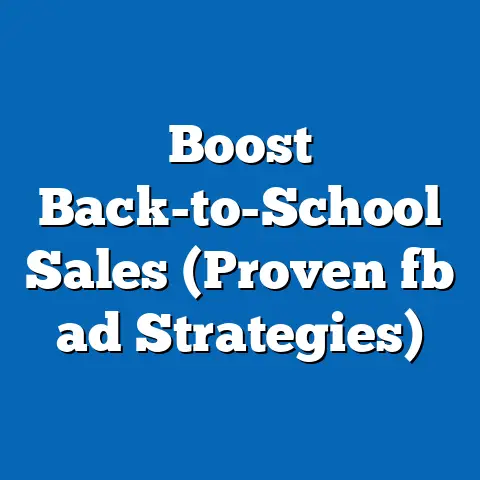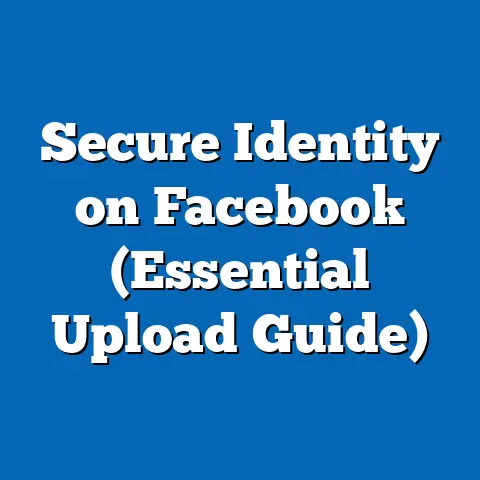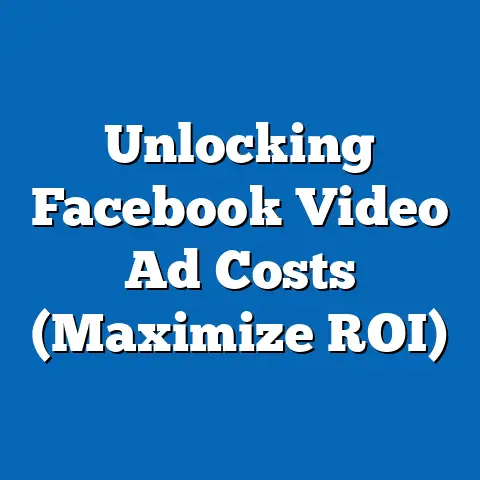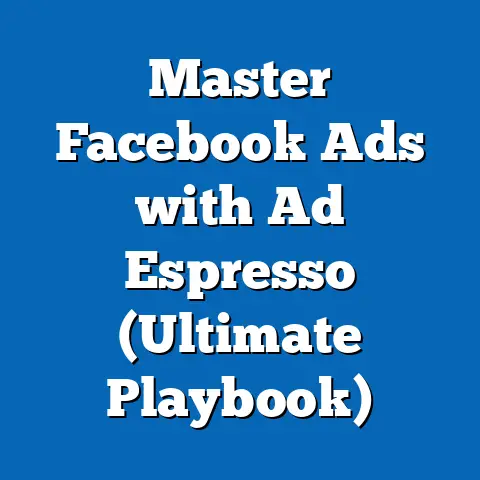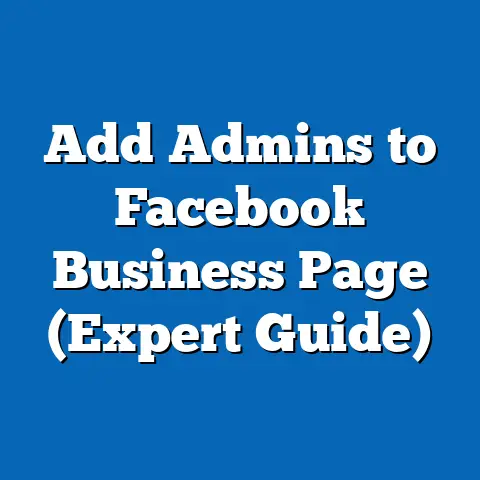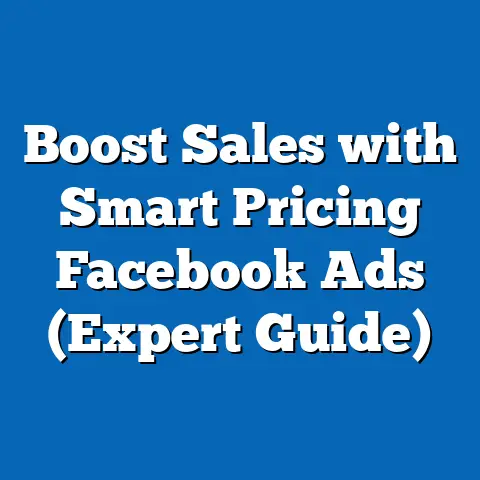Master Facebook Ads to Drive Results (Expert Insights)
The Common Mistake in Facebook Advertising: Ignoring Your Audience
One of the biggest mistakes I consistently see businesses make is launching Facebook Ads without a crystal-clear understanding of their target audience. It’s like throwing darts in the dark – you might hit something, but the chances of hitting the bullseye are slim. I remember working with a local bakery that was struggling to attract new customers. They were running generic ads promoting all their products to everyone in a 20-mile radius. The results? A lot of wasted ad spend and minimal return.
The problem wasn’t their delicious pastries; it was their targeting. They were essentially shouting into a void, hoping someone would hear them. This scattershot approach is far too common, and it’s a recipe for disappointment. According to a recent study by HubSpot, 61% of marketers say generating leads is their biggest challenge. And guess what? A poorly defined audience is a major contributor to that challenge.
Think about it: if you don’t know who you’re trying to reach, how can you craft compelling ad copy, choose the right visuals, or even select the appropriate ad placements? You can’t. You’re essentially guessing, and in the world of digital marketing, guessing is a surefire way to burn through your budget without seeing any meaningful results.
The solution? Audience segmentation and laser-focused targeting. It’s the foundation of any successful Facebook Ads campaign. It’s about understanding your ideal customer inside and out – their demographics, interests, behaviors, and pain points. When you know your audience, you can create ads that speak directly to them, address their needs, and ultimately, drive conversions.
Takeaway: Before you spend a single dollar on Facebook Ads, invest time in defining your target audience. It’s the most crucial step in achieving advertising success.
Understanding Facebook Ads
Facebook Ads have come a long way since their humble beginnings. What started as simple sidebar ads has evolved into a sophisticated advertising platform with a vast array of options and capabilities. Let’s break down the fundamentals.
A Brief History and Evolution
Facebook Ads officially launched in 2007, initially offering basic demographic targeting. Over the years, the platform has undergone significant transformations, adding features like behavioral targeting, custom audiences, lookalike audiences, and a host of creative ad formats. I remember when retargeting was first introduced – it was a game-changer! Suddenly, we could re-engage website visitors who had shown interest in our products or services.
The introduction of the Facebook Pixel was another pivotal moment. It allowed businesses to track conversions, optimize ad campaigns, and build more effective retargeting audiences. Today, Facebook Ads is a powerhouse, used by millions of businesses worldwide to reach billions of potential customers.
Different Types of Facebook Ads
Facebook offers a diverse range of ad formats, each designed for specific purposes and objectives. Here’s a rundown of the most common types:
-
Image Ads: These are the simplest and most widely used ad format, featuring a single image and accompanying text. They’re great for showcasing products, promoting events, or driving traffic to your website.
-
Video Ads: Video ads are highly engaging and can be used to tell stories, demonstrate product features, or build brand awareness. They can be short and snappy or longer and more in-depth.
-
Carousel Ads: Carousel ads allow you to display multiple images or videos in a single ad unit, each with its own headline, description, and link. They’re perfect for showcasing a range of products, highlighting different features of a single product, or telling a story in a sequential format.
-
Slideshow Ads: Slideshow ads combine multiple images or videos into a looping video format. They’re a cost-effective way to create engaging video content without the need for expensive video production.
-
Collection Ads: Collection ads are designed for e-commerce businesses and allow you to showcase a catalog of products in a visually appealing format. They typically feature a main image or video with a selection of related products displayed below.
Image Ads: These are the simplest and most widely used ad format, featuring a single image and accompanying text. They’re great for showcasing products, promoting events, or driving traffic to your website.
Video Ads: Video ads are highly engaging and can be used to tell stories, demonstrate product features, or build brand awareness. They can be short and snappy or longer and more in-depth.
Carousel Ads: Carousel ads allow you to display multiple images or videos in a single ad unit, each with its own headline, description, and link. They’re perfect for showcasing a range of products, highlighting different features of a single product, or telling a story in a sequential format.
Slideshow Ads: Slideshow ads combine multiple images or videos into a looping video format. They’re a cost-effective way to create engaging video content without the need for expensive video production.
Collection Ads: Collection ads are designed for e-commerce businesses and allow you to showcase a catalog of products in a visually appealing format. They typically feature a main image or video with a selection of related products displayed below.
Which ad format is right for you? It depends on your objectives, your target audience, and the type of content you have available. Experiment with different formats to see what resonates best with your audience.
The Facebook Ads Ecosystem
The Facebook Ads ecosystem is a complex network of tools, features, and algorithms that work together to deliver your ads to the right people at the right time. Let’s break it down:
-
Ads Manager: This is your central hub for creating, managing, and analyzing your Facebook Ads campaigns. It’s where you set your budget, choose your targeting options, design your ads, and track your performance.
-
Ad Placement Options: Facebook offers a variety of ad placements, including Facebook Feed, Instagram Feed, Audience Network, Messenger, and more. Each placement has its own unique characteristics and audience demographics.
-
The Algorithm: Facebook’s algorithm is the engine that powers the entire advertising platform. It analyzes billions of data points to determine which ads to show to which users, based on their interests, behaviors, and likelihood to engage.
Ads Manager: This is your central hub for creating, managing, and analyzing your Facebook Ads campaigns. It’s where you set your budget, choose your targeting options, design your ads, and track your performance.
Ad Placement Options: Facebook offers a variety of ad placements, including Facebook Feed, Instagram Feed, Audience Network, Messenger, and more. Each placement has its own unique characteristics and audience demographics.
The Algorithm: Facebook’s algorithm is the engine that powers the entire advertising platform. It analyzes billions of data points to determine which ads to show to which users, based on their interests, behaviors, and likelihood to engage.
Understanding how the Facebook Ads ecosystem works is crucial for creating successful campaigns. You need to know how to navigate the Ads Manager, choose the right ad placements, and understand how the algorithm works to optimize your ads for maximum performance.
Takeaway: Facebook Ads is a powerful and versatile advertising platform. By understanding the different ad formats and the intricacies of the ecosystem, you can create campaigns that reach the right people, deliver the right message, and drive real results.
Importance of Audience Targeting
As I mentioned earlier, audience targeting is the cornerstone of any successful Facebook Ads campaign. It’s the process of identifying and defining the specific group of people you want to reach with your ads.
Why Audience Targeting Matters
Think of audience targeting as aiming a rifle instead of a shotgun. Instead of blasting your message out to everyone and hoping someone bites, you’re carefully aiming at a specific target. This precision saves you money, increases engagement, and ultimately drives better results.
I’ve seen countless campaigns transformed simply by refining the audience targeting. For example, I worked with an online clothing boutique that was struggling to generate sales. They were targeting women aged 18-45 with a general interest in fashion. After conducting some in-depth audience research, we discovered that their ideal customer was actually a woman aged 25-35 with an interest in sustainable fashion and ethical brands. By narrowing their targeting, we saw a significant increase in their conversion rate and a decrease in their cost per acquisition.
Audience targeting allows you to:
- Reach the right people: Ensure your ads are seen by people who are actually interested in your products or services.
- Personalize your message: Tailor your ad copy and visuals to resonate with specific audience segments.
- Optimize your budget: Avoid wasting ad spend on people who are unlikely to convert.
- Improve your ROI: Drive better results by focusing your efforts on the most promising prospects.
Targeting Options Available on Facebook
Facebook offers a wide range of targeting options, allowing you to reach your ideal customer with incredible precision. Here’s a breakdown of the most common types:
- Demographics: Target users based on age, gender, location, education, relationship status, and more.
- Interests: Target users based on their interests, hobbies, and passions. Facebook gathers this information from the pages they like, the groups they join, and the topics they engage with.
- Behaviors: Target users based on their online behavior, such as purchase history, device usage, and travel habits.
- Custom Audiences: Create custom audiences based on your own data, such as email lists, website visitors, or app users. This allows you to retarget people who have already interacted with your business.
- Lookalike Audiences: Expand your reach by creating lookalike audiences, which are based on the characteristics of your existing customers. Facebook will identify users who share similar traits with your best customers.
The key to effective audience targeting is to combine different targeting options to create highly specific audience segments. For example, you could target women aged 25-35 who live in New York City, have an interest in sustainable fashion, and have visited your website in the past 30 days.
Researching and Defining Your Ideal Customer Persona
Before you can start targeting your audience, you need to understand who they are. This involves creating an ideal customer persona, which is a fictional representation of your perfect customer.
To create an ideal customer persona, ask yourself the following questions:
- What are their demographics (age, gender, location, income, education)?
- What are their interests and hobbies?
- What are their pain points and challenges?
- What are their goals and aspirations?
- Where do they spend their time online?
- What motivates them to make a purchase?
You can gather this information through a variety of methods, including:
- Customer surveys: Ask your existing customers about their demographics, interests, and pain points.
- Website analytics: Analyze your website traffic to identify the demographics, interests, and behaviors of your visitors.
- Social media insights: Use Facebook’s Audience Insights tool to learn more about your target audience.
- Competitor analysis: Research your competitors’ target audiences to identify potential opportunities.
Once you have a clear understanding of your ideal customer, you can use this information to create highly targeted Facebook Ads campaigns that resonate with your audience and drive results.
Takeaway: Audience targeting is the key to unlocking the full potential of Facebook Ads. By understanding your audience and using Facebook’s targeting options effectively, you can reach the right people, deliver the right message, and achieve your marketing goals.
Crafting Compelling Ad Copy and Visuals
Now that you’ve defined your target audience, it’s time to create ad copy and visuals that grab their attention and persuade them to take action.
Elements of Effective Ad Copy
Your ad copy is your opportunity to communicate your value proposition, address your audience’s pain points, and persuade them to click on your ad. Here are some key elements to consider:
- Hook: Start with a captivating hook that grabs the reader’s attention and makes them want to learn more. This could be a question, a surprising statistic, or a bold statement.
- Value Proposition: Clearly communicate the value you offer to your audience. What problem do you solve? What benefits do you provide?
- Call to Action (CTA): Tell your audience exactly what you want them to do. Use strong action verbs like “Shop Now,” “Learn More,” or “Get Started.”
Here’s an example of effective ad copy:
- Hook: Tired of struggling to find the perfect outfit?
- Value Proposition: Our online clothing boutique offers a curated selection of stylish and affordable pieces that will make you look and feel your best.
- CTA: Shop Now and get 20% off your first order!
The Role of Visuals in Ads
Visuals play a crucial role in attracting attention and conveying your message. Choose images and videos that are high-quality, relevant to your audience, and visually appealing.
Here are some best practices for image and video selection:
- Use high-quality images and videos: Avoid blurry or pixelated visuals.
- Choose visuals that are relevant to your audience: Use images and videos that resonate with their interests and preferences.
- Showcase your product or service: Highlight the features and benefits of what you’re offering.
- Use visuals that evoke emotion: Connect with your audience on an emotional level.
- Keep it simple: Avoid cluttered or confusing visuals.
Example: For a local coffee shop, I’d use a high-quality image of a perfectly poured latte with a cozy, inviting background. The copy would highlight the shop’s unique coffee blends and friendly atmosphere, ending with a CTA to “Visit Us Today!”
A/B Testing Ad Creatives
A/B testing, also known as split testing, involves creating two or more versions of your ad with slight variations and testing them against each other to see which performs best. This allows you to optimize your ad creatives for maximum impact.
Here are some elements you can A/B test:
- Headlines: Try different headlines to see which ones grab the most attention.
- Body copy: Experiment with different messaging to see which resonates best with your audience.
- Images and videos: Test different visuals to see which ones are most visually appealing and effective.
- CTAs: Try different calls to action to see which ones drive the most clicks and conversions.
Takeaway: Compelling ad copy and visuals are essential for capturing attention and persuading your audience to take action. By A/B testing different ad creatives, you can optimize your ads for maximum performance and drive better results.
Setting Up Your Campaign for Success
Now that you’ve crafted compelling ad copy and visuals, it’s time to set up your Facebook Ads campaign. This involves choosing your campaign objective, setting your budget and bids, selecting your ad placements, and more.
Step-by-Step Guide to Setting Up a Facebook Ads Campaign
- Choose Your Campaign Objective: Facebook offers a variety of campaign objectives, each designed for a specific purpose. These include:
- Awareness: Reach a broad audience and increase brand awareness.
- Traffic: Drive traffic to your website or landing page.
- Engagement: Encourage engagement with your Facebook page or posts.
- Leads: Generate leads for your business.
- App Installs: Drive installs of your mobile app.
- Sales: Drive sales of your products or services.
- Set Your Budget and Bids: Determine how much you’re willing to spend on your campaign and how much you’re willing to pay for each click or impression. You can choose between a daily budget or a lifetime budget.
- Select Your Audience: Choose your target audience based on demographics, interests, behaviors, and custom audiences.
- Choose Your Ad Placements: Select the ad placements where you want your ads to appear. You can choose between automatic placements (where Facebook optimizes your placements for you) or manual placements (where you choose your placements yourself).
- Design Your Ads: Create your ad copy and visuals, and choose your call to action.
- Track Your Results: Monitor your campaign performance and make adjustments as needed.
- Awareness: Reach a broad audience and increase brand awareness.
- Traffic: Drive traffic to your website or landing page.
- Engagement: Encourage engagement with your Facebook page or posts.
- Leads: Generate leads for your business.
- App Installs: Drive installs of your mobile app.
- Sales: Drive sales of your products or services.
Importance of Selecting the Right Ad Placements
Ad placement refers to where your ads appear on Facebook and its network. The right placement can significantly impact your ad’s performance.
Here are some of the most common ad placements:
- Facebook Feed: This is the most common ad placement, appearing in users’ news feeds alongside organic content.
- Instagram Feed: This placement appears in users’ Instagram feeds.
- Audience Network: This placement allows you to extend your reach beyond Facebook and Instagram to a network of third-party websites and apps.
- Messenger: This placement allows you to reach users through Facebook Messenger.
Optimizing for Mobile Users
With the majority of Facebook users accessing the platform on mobile devices, it’s crucial to optimize your ads for mobile.
Here are some tips for optimizing for mobile:
- Use mobile-friendly ad formats: Choose ad formats that are designed for mobile devices, such as video ads and carousel ads.
- Keep your ad copy concise: Mobile users have shorter attention spans, so keep your ad copy short and to the point.
- Use clear and compelling visuals: Choose visuals that are easy to see and understand on small screens.
- Make sure your landing page is mobile-friendly: Ensure your landing page is optimized for mobile devices, with a responsive design and fast loading times.
Using Facebook Pixel for Tracking Conversions and Retargeting
The Facebook Pixel is a snippet of code that you place on your website to track conversions and retarget website visitors. It’s an essential tool for any serious Facebook advertiser.
Here’s how the Facebook Pixel works:
- When someone visits your website, the Facebook Pixel drops a cookie on their browser.
- The Pixel tracks their behavior on your website, such as the pages they visit, the products they view, and the purchases they make.
- This data is sent back to Facebook, allowing you to track conversions, optimize your ads, and retarget website visitors.
Takeaway: Setting up your Facebook Ads campaign correctly is crucial for achieving success. By choosing the right campaign objective, setting your budget and bids, selecting your ad placements, and optimizing for mobile users, you can create campaigns that reach the right people, deliver the right message, and drive real results.
Analyzing Performance and Metrics
Once your campaign is up and running, it’s essential to monitor its performance and make adjustments as needed. This involves tracking key metrics, analyzing your results, and making data-driven decisions to optimize your campaign.
Key Metrics to Monitor
Here are some of the most important metrics to monitor when running Facebook Ads:
- Impressions: The number of times your ad is displayed.
- Reach: The number of unique people who saw your ad.
- Click-Through Rate (CTR): The percentage of people who saw your ad and clicked on it.
- Cost Per Click (CPC): The average cost you pay for each click on your ad.
- Cost Per Mille (CPM): The average cost you pay for 1,000 impressions of your ad.
- Conversion Rate: The percentage of people who clicked on your ad and completed a desired action, such as making a purchase or filling out a form.
- Cost Per Acquisition (CPA): The average cost you pay for each conversion.
- Return on Ad Spend (ROAS): The amount of revenue you generate for every dollar you spend on ads.
Reading and Interpreting Facebook Ads Reports
Facebook Ads Manager provides a wealth of data about your campaign performance. Learning how to read and interpret these reports is essential for optimizing your ads.
Here are some tips for reading Facebook Ads reports:
- Focus on the metrics that matter: Don’t get bogged down in irrelevant data. Focus on the metrics that are most important to your campaign objective.
- Compare your results to benchmarks: See how your campaign performance compares to industry benchmarks.
- Look for trends and patterns: Identify trends and patterns in your data to understand what’s working and what’s not.
- Segment your data: Segment your data by demographics, interests, and behaviors to identify your most valuable audience segments.
Importance of Continuous Testing and Iteration
The world of Facebook Ads is constantly evolving, so it’s essential to continuously test and iterate your campaigns. This involves trying new targeting options, ad creatives, and bidding strategies to see what works best.
Here are some tips for continuous testing and iteration:
- Set up A/B tests: Test different versions of your ads against each other to see which performs best.
- Monitor your campaign performance closely: Track your results and make adjustments as needed.
- Stay up-to-date with the latest trends: Keep abreast of the latest trends in Facebook Ads and experiment with new features and strategies.
Takeaway: Analyzing your campaign performance is crucial for optimizing your Facebook Ads and achieving your marketing goals. By monitoring key metrics, reading and interpreting Facebook Ads reports, and continuously testing and iterating your campaigns, you can drive better results and maximize your ROI.
Navigating Common Challenges
Even with a well-planned campaign, you may encounter challenges along the way. Here are some common issues and how to address them:
Ad Fatigue
Ad fatigue occurs when your audience gets tired of seeing the same ads over and over again. This can lead to a decrease in engagement and a decline in performance.
To combat ad fatigue, try the following:
- Rotate your ad creatives: Regularly update your ad copy and visuals to keep things fresh.
- Expand your targeting: Reach new audience segments to avoid saturating your existing audience.
- Use dynamic creative optimization: Let Facebook automatically optimize your ad creatives for different audience segments.
Audience Saturation
Audience saturation occurs when you’ve reached the maximum number of people in your target audience. This can lead to a decrease in reach and an increase in cost per click.
To overcome audience saturation, try the following:
- Expand your targeting: Reach new audience segments by broadening your demographics, interests, or behaviors.
- Create lookalike audiences: Expand your reach by creating lookalike audiences based on your existing customers.
- Use retargeting: Re-engage website visitors who haven’t yet converted.
Policy Violations
Facebook has strict advertising policies that you must adhere to. Violating these policies can result in your ads being disapproved or your account being suspended.
To avoid policy violations, be sure to:
- Read and understand Facebook’s advertising policies: Familiarize yourself with the rules and regulations.
- Avoid making false or misleading claims: Be truthful and accurate in your ad copy.
- Respect intellectual property rights: Don’t use copyrighted material without permission.
- Comply with all applicable laws and regulations: Ensure your ads comply with all relevant laws and regulations.
The Evolving Landscape of Digital Advertising
The world of digital advertising is constantly changing, so it’s essential to stay up-to-date with the latest trends and technologies. This includes the impact of privacy changes, algorithm updates, and new ad formats.
To stay ahead of the curve, be sure to:
- Read industry blogs and publications: Stay informed about the latest trends and best practices.
- Attend industry conferences and webinars: Learn from experts and network with other advertisers.
- Experiment with new features and strategies: Don’t be afraid to try new things and see what works best.
Takeaway: Navigating the challenges of Facebook Ads requires a proactive and adaptive approach. By understanding the common pitfalls and staying up-to-date with the latest trends, you can overcome these challenges and maintain a successful advertising strategy.
Building a Sustainable Facebook Ads Strategy
Mastering Facebook Ads is an ongoing process that requires continuous learning, adaptation, and optimization. By implementing the insights shared in this article, you can enhance your Facebook advertising efforts and achieve your marketing goals.
Here are some key takeaways to remember:
- Define your target audience: Audience targeting is the foundation of any successful Facebook Ads campaign.
- Craft compelling ad copy and visuals: Use high-quality visuals and persuasive ad copy to capture attention and drive action.
- Set up your campaign for success: Choose the right campaign objective, set your budget and bids, and select your ad placements carefully.
- Analyze your performance and metrics: Monitor your campaign performance and make adjustments as needed.
- Navigate common challenges: Be aware of the common pitfalls and learn how to overcome them.
- Stay up-to-date with the latest trends: The world of digital advertising is constantly evolving, so it’s essential to stay informed and adapt your strategies accordingly.
Facebook Ads can be a powerful tool for driving tangible results for your business. By following these expert insights and building a sustainable advertising strategy, you can unlock the full potential of the platform and achieve your marketing objectives. Now go out there and create some amazing Facebook Ads!

